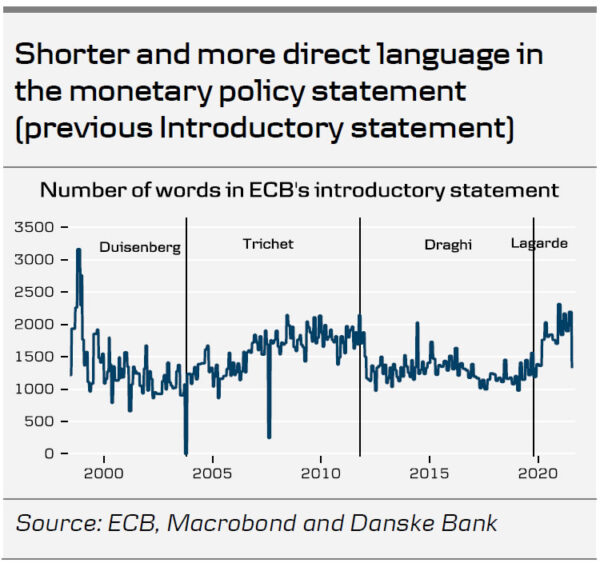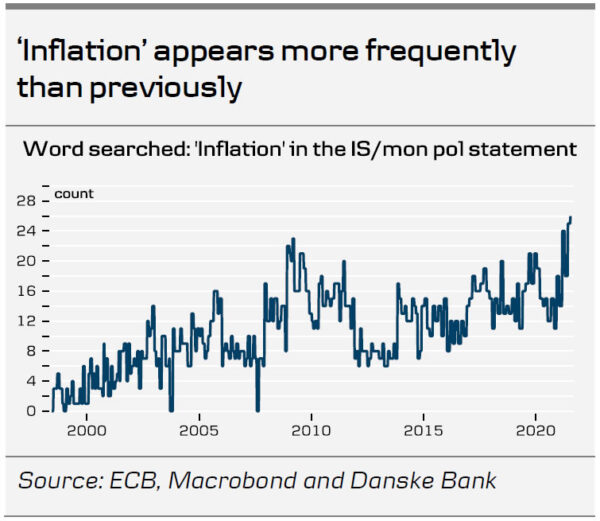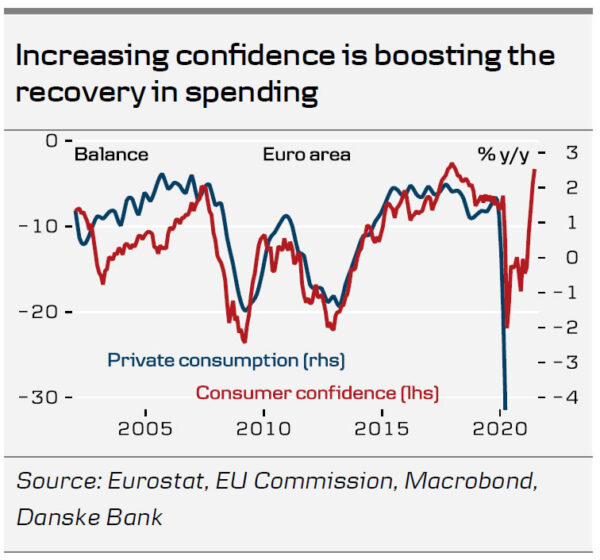- ECB’s first meeting since the new strategy took effect was mostly about aligning the language from the June decision to the review outcome. The bond buying (APP and PEPP) guidance were unchanged.
- The main new element worth highlighting is the forward guidance on rates stating that inflation has to reach ‘two per cent well ahead of the end of its projection horizon and durably for the rest of the projection horizon’ which compares ‘to the end of the forecast horizon’ in June.
- This also means that the new strategy is more focused on the duration of the accommodative policy stance and not the size of the support.
- There was ‘disagreement at the margin’ on the wording.
- Overall, markets showed only limited reactions to the meeting.
Stepped up inflation ambitions…
The July ECB meeting marked the first time we are seeing the new monetary strategy in action (see also Flash: ECB Research – Strategic Review: Striving for symmetry, 8 July 2021). As policy rates have been close to the lower bound for some time and the mediumterm inflation outlook remains well below target, ECB has adjusted its forward guidance on rates, in an attempt to underline its commitment to maintain a persistently accommodative monetary policy stance. Policy rates are now expected to remain at their present or lower levels until ECB sees inflation reaching 2% well ahead of the end of its projection horizon and durably for the rest of the projection horizon, and that this is also confirmed by underlying inflation. This may also imply a transitory period in which inflation is moderately above target. Further, this also means that ECB wants to observe realised inflation printing closer to / at the target earlier in the forecast horizon (currently until 2023) compared to the earlier medium-term orientation (end of forecast horizon).
…But without new monetary policy stimulus
Maintaining favourable financing conditions remains key for the recovery to turn into a lasting expansion and hence ECB bond purchase programmes will continue unchanged. The total PEPP envelope continues to amount to EUR 1850bn, with purchases conducted at least until March 22 and at ‘significantly’ higher pace in Q3 21 than compared to the start of the year, while APP purchases continue at a pace of EUR 20bn/month.
Overall, the new forward guidance on rates is slightly more dovish than previously in our view, as it allows for a more persistent easy monetary policy stance. However, despite the changes in the wording, we do not see it as much of a change in substance: no new monetary policy signals have been sent and the change is more related to the duration of support rather than the size of monetary stimulus.
Economic recovery on track, but inflation remains off target
Comments from President Lagarde suggested a continued constructive view on the economy, while the inflation outlook remains a cause of concern. The euro area recovery was seen on track, as vaccinations have accelerated and lockdown restrictions been eased. However, the pandemic also continues to cast a shadow, especially related to uncertainty from the spreading of the delta variant for service sector activity. Employment is still some 3.3mio below pre-crisis levels and many people remain on job retention schemes. Overall, risks to the economic outlook remain broadly balanced. This is important in our view, as a PEPP extension would likely require downside risks coming to the fore again.
The inflation increase this year was still seen as temporary by the ECB due to energy and German VAT base effects and the outlook for inflation over medium-term remained subdued. Longer-term inflation expectations have increased, but still remain some way off the 2% target. Significant slack in economy and weak wage growth are holding back underlying inflation pressures, despite supply chain cost pressures Overall, Lagarde stressed that there is still some way to go before the fallout from the pandemic on inflation is eliminated. We share the this view, see Research Euro Area – Mind the inflation gap, 8 June 2021.
Market reaction
As expected, the ECB meeting was a non-event for FX markets. The EUR initially found its clue from relative EUR fixed income performance but during the press conference the single currency stabilised at close to unchanged levels for the day. Looking ahead, we strategically favour more EUR/USD downside but emphasise that this is much more a play on USD real rates, global inflation exposure and global cross asset moves than it is a play on ECB monetary policy.
Regarding bond markets, we saw a small amount of volatility during the press conference, with 10y German Bund touching -42bp, but ended virtually unchanged around -40bp, the level also heading into the 13:45 decision. The front of the curve is set to remain anchored for a long time and the front end is now also subject to significant directional risk. Furthermore, this leaves the 10y leg as the determining factor for curve slopes, see more in COTW: Central banks are not the only game in town, 1 July 2021.















